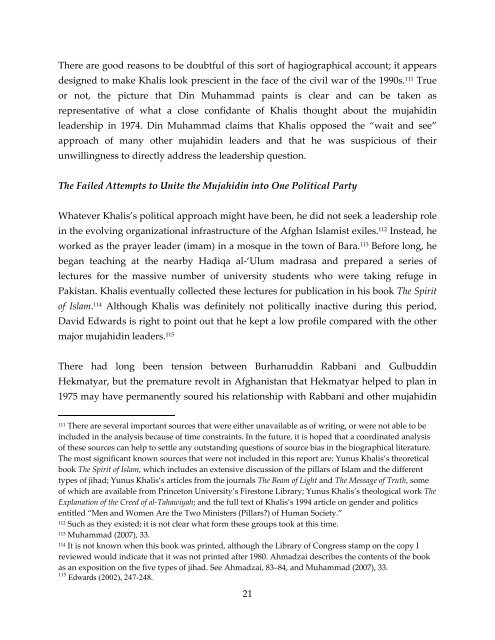Usama bin Ladin’s “Father Sheikh”:
Usama bin Ladin’s “Father Sheikh”:
Usama bin Ladin’s “Father Sheikh”:
You also want an ePaper? Increase the reach of your titles
YUMPU automatically turns print PDFs into web optimized ePapers that Google loves.
There are good reasons to be doubtful of this sort of hagiographical account; it appears<br />
designed to make Khalis look prescient in the face of the civil war of the 1990s. 111 True<br />
or not, the picture that Din Muhammad paints is clear and can be taken as<br />
representative of what a close confidante of Khalis thought about the mujahidin<br />
leadership in 1974. Din Muhammad claims that Khalis opposed the “wait and see”<br />
approach of many other mujahidin leaders and that he was suspicious of their<br />
unwillingness to directly address the leadership question.<br />
The Failed Attempts to Unite the Mujahidin into One Political Party<br />
Whatever Khalis’s political approach might have been, he did not seek a leadership role<br />
in the evolving organizational infrastructure of the Afghan Islamist exiles. 112 Instead, he<br />
worked as the prayer leader (imam) in a mosque in the town of Bara. 113 Before long, he<br />
began teaching at the nearby Hadiqa al‐‘Ulum madrasa and prepared a series of<br />
lectures for the massive number of university students who were taking refuge in<br />
Pakistan. Khalis eventually collected these lectures for publication in his book The Spirit<br />
of Islam. 114 Although Khalis was definitely not politically inactive during this period,<br />
David Edwards is right to point out that he kept a low profile compared with the other<br />
major mujahidin leaders. 115<br />
There had long been tension between Burhanuddin Rabbani and Gulbuddin<br />
Hekmatyar, but the premature revolt in Afghanistan that Hekmatyar helped to plan in<br />
1975 may have permanently soured his relationship with Rabbani and other mujahidin<br />
111 There are several important sources that were either unavailable as of writing, or were not able to be<br />
included in the analysis because of time constraints. In the future, it is hoped that a coordinated analysis<br />
of these sources can help to settle any outstanding questions of source bias in the biographical literature.<br />
The most significant known sources that were not included in this report are: Yunus Khalis’s theoretical<br />
book The Spirit of Islam, which includes an extensive discussion of the pillars of Islam and the different<br />
types of jihad; Yunus Khalis’s articles from the journals The Beam of Light and The Message of Truth, some<br />
of which are available from Princeton University’s Firestone Library; Yunus Khalis’s theological work The<br />
Explanation of the Creed of al‐Tahawiyah; and the full text of Khalis’s 1994 article on gender and politics<br />
entitled “Men and Women Are the Two Ministers (Pillars?) of Human Society.”<br />
112 Such as they existed; it is not clear what form these groups took at this time.<br />
113 Muhammad (2007), 33.<br />
114 It is not known when this book was printed, although the Library of Congress stamp on the copy I<br />
reviewed would indicate that it was not printed after 1980. Ahmadzai describes the contents of the book<br />
as an exposition on the five types of jihad. See Ahmadzai, 83–84, and Muhammad (2007), 33.<br />
115 Edwards (2002), 247-248.<br />
21


